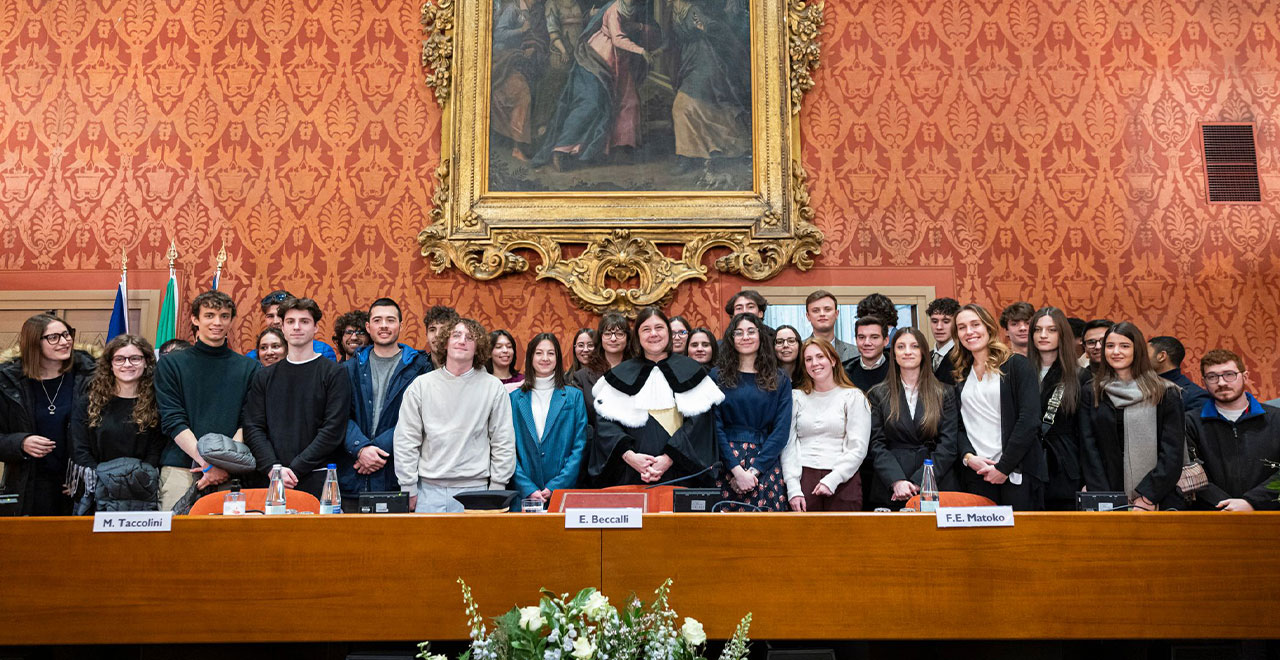
News | Inaugurazione anno accademico
Beccalli, l’education power e il metodo bresciano
Il discorso inaugurale del rettore al Dies Academicus della sede di Brescia punta sull’apertura al territorio, al mondo e all’Africa
| Elena Beccalli
04 marzo 2025
Condividi su:

An inauguration characterised by openness: to the territory, to the world and to solidarity with the African continent, in line with the aspirations of the Africa Plan of Università Cattolica del Sacro Cuore. “Here in Brescia, education power is expressed through strategic alliances with local institutions, associations and communities ‒ being able to count on a widespread and interconnected local network” said the Rector Elena Beccalli in her inaugural speech at the Dies Academicus of Brescia, in which she identified a Brescian method based on constant dialogue with the territory, which “contributes to making this city an educational centre that is increasingly recognised at a national and international level.”
This was also emphasised by the mayor of Brescia, Laura Castelletti, who expressed the will of the municipal administration to create a network and share means and resources. “In this spirit, we intend to further strengthen the collaboration with the Catholic University to develop common projects that can enrich the cultural offer for the city and create new opportunities for young people.”
A concept taken up in his greeting by the president of the Ente Bresciano per l’Istruzione Superiore (EBIS) [tr. Brescia Higher Education Organisation] Alessandro Azzi, according to whom “the University can play an important role, but to do so successfully it must be able to dialogue more and more with the territory, both qualitatively and quantitatively”. For this reason, “EBIS aims to develop even more effectively the role of ‘operational body for listening and transmission’, providing increasingly useful support for the Brescia campus of the University.”
The dimension of openness was also identified by the Bishop of Brescia, Monsignor Pierantonio Tremolada, in his address of greeting, referring to the name of the University and recalling that “authentically Catholic is everything that ‒ precisely because it is universal ‒ has vast horizons, harmoniously embraces peoples and cultures, faces the radical questions in which everyone recognises themselves, loves free and respectful encounters and exchanges, contributes to building the common good and is passionate about the honest search for that truth that is valid for everyone.”
An article by


An openness to the world that the Rector emphasised in the first part of her speech, where, citing the 50% of students who come from other countries on the new degree course in Business and Finance, she explained that “Brescia can aspire to become an internationally attractive university city” and to “qualify as a global microcosm”. There are 166 international students enrolled in Brescia, “a number that says a lot about the attractiveness of the location for second-generation young people. The new structure in Via della Garzetta is a perfect example of this because, more than others, it reflects the characteristics of US campuses, acting as a pivot to make Brescia a global university city in all respects.”
In this dimension of openness to the world, a special place is occupied by Africa, a continent experiencing strong growth (2.5 billion people in 2050), which will represent 25% of the global population, while Italy will only represent 0.5%. “The youth demographic boom in Africa could prove to be the region’s most valuable resource in the near future, when other parts of the world will be facing an ageing population and labour shortages,” said the Rector, who pointed out that “Europe is struggling to cultivate the potential benefits of this strategic proximity. A gloomy situation in which education could become the keystone.” Also because the low level of education remains “a serious obstacle that we must strive to remove”. Suffice it to say that “about 98 million African children and young people do not have access to primary and secondary education”, constituting a real “educational catastrophe.”
This analysis was echoed in the opening speech, with its light and shade, by Firmin Edouard Matoko, Assistant Director-General for Priority Africa and External Relations at UNESCO. “According to a 2024 report by the African Development Bank (ADB), Africa is the second fastest growing region in the world after Asia, with as many as 41 countries on the rise.” Unfortunately, “there are still reasons for concern, as revealed by the official statistics on poverty. A third of the African population still lives below the poverty line, while more than half has no access to electricity”. The process of growth and transformation of a continent “where more than 50% of the population is young, where a third of the adult population is still illiterate, and, above all, where social and cultural barriers to basic education still exist, especially for girls” is also very long, and one of the major challenges is that of youth unemployment.
However, there is no lack of reasons for hope: “54 countries that are part of the African Union”, with different political, social and economic trajectories and more than two thousand languages and dialects in use, “have adopted a common pan-African vision, Agenda 2063 (The Africa We Want!), with the ambition of building ‘an integrated, prosperous and peaceful Africa, driven by its own citizens and representing a dynamic force in the international arena’.”
It is on the basis of these hopes that the Africa Plan of Università Cattolica del Sacro Cuore was created, and presented for the first time during the inauguration of the academic year in Milan. “Our great aspiration,” says Professor Beccalli, “is to become the European university with the most significant presence in Africa, with a view to mutual enrichment, for the integral formation of people and the promotion of peace. The cornerstone of this project is the expansion of educational programmes, also provided remotely in partnership with African universities, and at the same time, the integration of our students’ volunteer experiences into their academic programmes.”
Vera Brunelli, a PhD student, spoke about volunteering in Africa, based on the Service Learning experience, and told us about her project with the schools of Maison de Paix, in the Democratic Republic of the Congo, which had the support of the University's first UNESCO Chair, established in Brescia in 2018. A process of cooperation that has become “an increasingly necessary approach for me in research work that sees cooperation and the respectful and authentic exchange of knowledge, and not competition, as the way to overcome what we can define as real ‘epistemic injustices’.”
With 123 projects active in 40 African countries, 10 of which are in the Brescia office alone, “the Africa Plan intends to expand the network of initiatives already in place.” A forerunner of this action structure in the Brescia area was Vittorino Chizzolini, the true founder of international cooperation in the city. It was perhaps not by chance that he was also the one who, in dialogue with Father Gemelli, gave a strong impetus to the foundation of the Brescia campus of Università Cattolica, which celebrates its sixtieth anniversary this year.
A campus that has been able to express its triple openness to the territory, to the world and to Africa. “Sixty years of presence is not a short time. We are a qualified, recognised and recognisable institution; the numerous certificates of merit make us proud, but, at the same time, encourage us to do even better. I am convinced that one of the keys to this success lies in having been able to apply what I call education power in a very special way.”